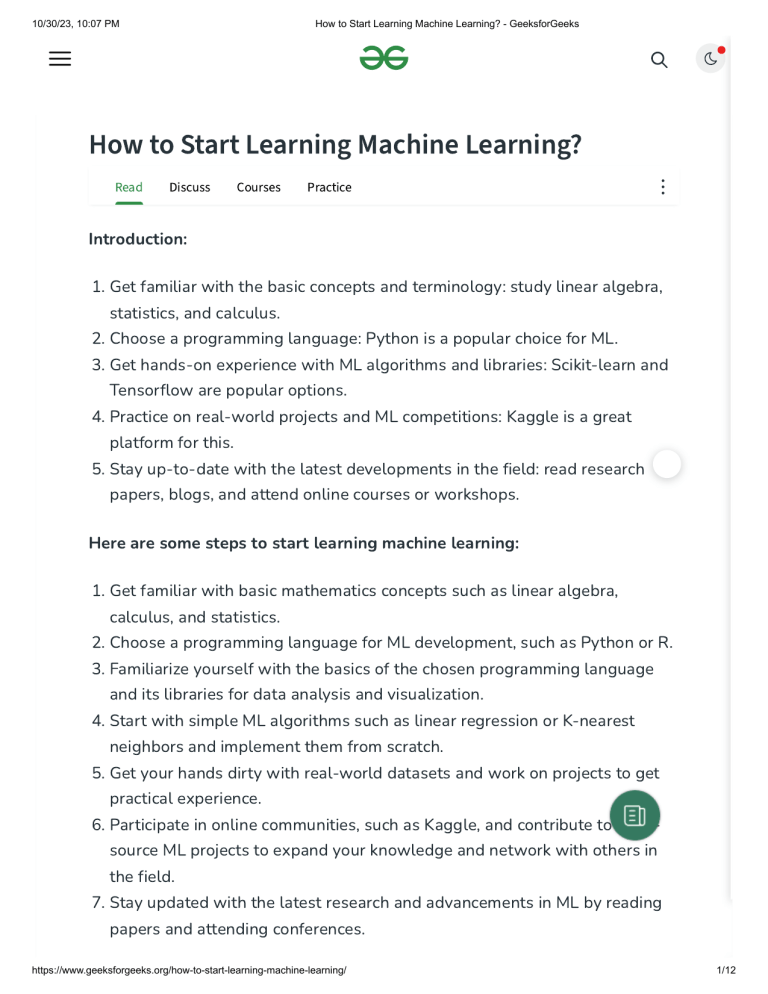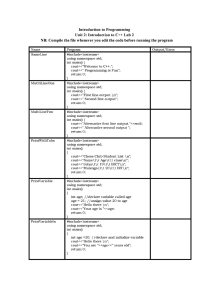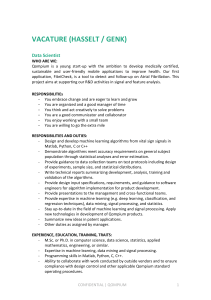
10/30/23, 10:07 PM How to Start Learning Machine Learning? - GeeksforGeeks How to Start Learning Machine Learning? Read Discuss Courses Practice Introduction: 1. Get familiar with the basic concepts and terminology: study linear algebra, statistics, and calculus. 2. Choose a programming language: Python is a popular choice for ML. 3. Get hands-on experience with ML algorithms and libraries: Scikit-learn and Tensorflow are popular options. 4. Practice on real-world projects and ML competitions: Kaggle is a great platform for this. 5. Stay up-to-date with the latest developments in the field: read research papers, blogs, and attend online courses or workshops. Here are some steps to start learning machine learning: 1. Get familiar with basic mathematics concepts such as linear algebra, calculus, and statistics. 2. Choose a programming language for ML development, such as Python or R. 3. Familiarize yourself with the basics of the chosen programming language and its libraries for data analysis and visualization. 4. Start with simple ML algorithms such as linear regression or K-nearest neighbors and implement them from scratch. 5. Get your hands dirty with real-world datasets and work on projects to get practical experience. 6. Participate in online communities, such as Kaggle, and contribute to opensource ML projects to expand your knowledge and network with others in the field. 7. Stay updated with the latest research and advancements in ML by reading papers and attending conferences. https://www.geeksforgeeks.org/how-to-start-learning-machine-learning/ 1/12 10/30/23, 10:07 PM How to Start Learning Machine Learning? - GeeksforGeeks Note: The most important aspect of learning ML is to have a strong foundation in mathematics, statistics and a good understanding of programming. Arthur Samuel coined the term “Machine Learning” in 1959 and defined it as a “Field of study that gives computers the capability to learn without being explicitly programmed”. And that was the beginning of Machine Learning! In modern times, Machine Learning is one of the most popular (if not the most!) career choices. According to a survey, Machine Learning Engineer Is The Best Job of the decade and is expected to grow YoY by 22% (between 2020-2030) and an average base salary of $122,000 per year in USA and INR 8.5LPA in India. What is Machine Learning? Machine Learning involves the use of Artificial Intelligence to enable machines to learn a task from experience without programming them specifically about that task. (In short, Machines learn automatically without human hand holding!!!) This process starts with feeding them good quality data and then training the machines by building various machine learning models using the data and different algorithms. The choice of algorithms depends on what type of data do we have and what kind of task we are trying to automate. Why Do We use Machine Learning? https://www.geeksforgeeks.org/how-to-start-learning-machine-learning/ 2/12 10/30/23, 10:07 PM How to Start Learning Machine Learning? - GeeksforGeeks As we’re moving forward in the digital world, a massive amount of data is being generated every single minute along with the accessibility of high-speed internet. This is the major factor to develop automated systems that can handle data at such a threshold by accurately using different algorithms for complex data sets. Today, companies of all scales are using this method to handle cost management, lower the risk, and also help in improving the quality of their product and services. This technology has been widely accepted in many industries today and soon it’s going to be a major part of our lives. (which has already begun) How to Start Learning ML? This is a rough roadmap you can follow on your way to becoming an insanely talented Machine Learning Engineer. Of course, you can always modify the steps according to your needs to reach your desired end goal! Step 1 – Understand the Prerequisites In case you are a genius, you could start ML directly but normally, there are some prerequisites that you need to know which include Linear Algebra, Multivariate Calculus, Statistics, and Python. And if you don’t know these, never fear! You don’t need a Ph.D. degree in these topics to get started but you do need a basic understanding. (a) Learn Linear Algebra and Multivariate Calculus Both Linear Algebra and Multivariate Calculus are important in Machine Learning. However, the extent to which you need them depends on your role as a data scientist. If you are more focused on application-heavy machine learning, then you will not be that heavily focused on maths as there are many common libraries available. But if you want to focus on R&D in Machine Learning, then mastery of Linear Algebra and Multivariate Calculus is very important as you will have to implement many ML algorithms from scratch. (b) Learn Statistics Data plays a huge role in Machine Learning. In fact, around 80% of your time as an ML expert will be spent collecting and cleaning data. And statistics is a field that handles the collection, analysis, and presentation of data. So it is no https://www.geeksforgeeks.org/how-to-start-learning-machine-learning/ 3/12 10/30/23, 10:07 PM How to Start Learning Machine Learning? - GeeksforGeeks surprise that you need to learn it!!! Some of the key concepts in statistics that are important are Statistical Significance, Probability Distributions, Hypothesis Testing, Regression, etc. Also, Bayesian Thinking is also a very important part of ML which deals with various concepts like Conditional Probability, Priors, and Posteriors, Maximum Likelihood, etc. (c) Learn Python Some people prefer to skip Linear Algebra, Multivariate Calculus, and Statistics and learn them as they go along with trial and error. But the one thing that you absolutely cannot skip is Python! While there are other languages you can use for Machine Learning like R, Scala, etc. Python is currently the most popular language for ML. In fact, there are many Python libraries that are specifically useful for Artificial Intelligence and Machine Learning such as Keras, TensorFlow, Scikit-learn, etc. Step 2 – Learn Various ML Concepts Now that you are done with the prerequisites, you can move on to actually learning ML (where the fun begins!!!) It’s best to start with the basics and then move on to the more complicated stuff. Some of the basic concepts in ML are: (a) Terminologies of Machine Learning Model – A model is a specific representation learned from data by applying some machine learning algorithm. A model is also called a hypothesis. Feature – A feature is an individual measurable property of the data. A set of numeric features can be conveniently described by a feature vector. Feature vectors are fed as input to the model. For example, in order to predict a fruit, there may be features like color, smell, taste, etc. Target (Label) – A target variable or label is the value to be predicted by our model. For the fruit example discussed in the feature section, the label with each set of input would be the name of the fruit like apple, orange, banana, etc. Training – The idea is to give a set of inputs(features) and its expected outputs(labels), so after training, we will have a model (hypothesis) that will then map new data to one of the categories trained on. https://www.geeksforgeeks.org/how-to-start-learning-machine-learning/ 4/12 10/30/23, 10:07 PM How to Start Learning Machine Learning? - GeeksforGeeks Prediction – Once our model is ready, it can be fed a set of inputs to which it will provide a predicted output(label). (b) Types of Machine Learning Supervised Learning – This involves learning from a training dataset with labeled data using classification and regression models. This learning process continues until the required level of performance is achieved. Unsupervised Learning – This involves using unlabeled data and then finding the underlying structure in the data in order to learn more and more about the data itself using factor and cluster analysis models. Semi-supervised Learning – This involves using unlabeled data like Unsupervised Learning with a small amount of labeled data. Using labeled data vastly increases the learning accuracy and is also more cost-effective than Supervised Learning. Reinforcement Learning – This involves learning optimal actions through trial and error. So the next action is decided by learning behaviors that are based on the current state and that will maximize the reward in the future. (c) How to Tutorial Practise Machine Learning? Machine Learning Data Analysis Tutorial Python – Data visualization tutorial NumPy Pandas OpenCV The most time-consuming part of ML is actually data collection, integration, cleaning, and preprocessing. So make sure to practice with this because you need high-quality data but large amounts of data are often dirty. So this is where most of your time will go!!! Learn various models and practice on real datasets. This will help you in creating your intuition around which types of models are appropriate in different situations. Along with these steps, it is equally important to understand how to interpret the results obtained by using different models. This is easier to do if you understand various tuning parameters and regularization methods applied to different models. (d) Resources for Learning Machine Learning: There are various online and offline resources (both free and paid!) that can be used to learn Machine Learning. Some of these are provided here: https://www.geeksforgeeks.org/how-to-start-learning-machine-learning/ 5/12 10/30/23, 10:07 PM How to Start Learning Machine Learning? - GeeksforGeeks For a broad introduction to Machine Learning, Stanford’s Machine Learning Course by Andrew Ng is quite popular. It focuses on machine learning, data mining, and statistical pattern recognition with explanation videos are very helpful in clearing up the theory and core concepts behind ML. If you want a self-study guide to Machine Learning, then Geeksforgeeks Machine Learning Basic and Advanced – Self Paced course will be ideal for you. This course will teach you about various concepts of Machine Learning and also practical experience in implementing them in a classroom environment. Step 3 – Take Part in Competitions After you have understood the basics of Machine Learning, you can move on to the crazy part!!! Competitions! These will basically make you even more proficient in ML by combining your mostly theoretical knowledge with practical implementation. Some of the basic competitions that you can start with on Kaggle that will help you build confidence are given here: Titanic: Machine Learning from Disaster: The Titanic: Machine Learning from Disaster challenge is a very popular beginner project for ML as it has multiple tutorials available. So it is a great introduction to ML concepts like data exploration, feature engineering, and model tuning. Digit Recognizer: The Digit Recognizer is a project after you have some knowledge of Python and ML basics. It is a great introduction to the exciting world of neural networks using a classic dataset that includes pre-extracted features. After you have completed these competitions and other such simple challenges …Congratulations!!! You are well on your way to becoming a fullfledged Machine Learning Engineer and you can continue enhancing your skills by working on more and more challenges and eventually creating more and more creative and difficult Machine Learning projects. Advantages or Disadvantages: Advantages: https://www.geeksforgeeks.org/how-to-start-learning-machine-learning/ 6/12 10/30/23, 10:07 PM How to Start Learning Machine Learning? - GeeksforGeeks 1. High demand for ML experts in the job market. 2. Can improve decision-making and automate repetitive tasks. 3. Can be applied to a variety of fields and industries.Here are some of the advantages of machine learning: 4. Automation: Machine learning algorithms can automate decision-making processes, reducing the need for human intervention. 5. Improved accuracy: Machine learning algorithms can be trained on large datasets to identify patterns and make predictions with higher accuracy compared to traditional methods. 6. Efficient data analysis: Machine learning algorithms can process vast amounts of data much faster than humans, making it easier to extract insights and make data-driven decisions. 7. Personalization: Machine learning algorithms can be used to personalize experiences for users, such as personalized recommendations and advertisements. 8. Predictive maintenance: Machine learning algorithms can be used to predict equipment failures, reducing downtime and maintenance costs. 9. Fraud detection: Machine learning algorithms can be used to detect and prevent fraudulent activities in various industries, such as finance and ecommerce. 10. Improved healthcare: Machine learning algorithms can be used to analyze patient data, diagnose diseases and recommend treatments, improving healthcare outcomes. Disadvantages: 1. Can be time-consuming to train models. 2. May produce biased or unethical results if not properly monitored. 3. Can be complex and challenging to understand. 4. May replace certain jobs with automation. 5. Bias: Machine learning algorithms can be biased if the training data contains biases, leading to incorrect predictions and unfair treatment of certain groups. 6. Lack of transparency: Machine learning algorithms can be complex and difficult to interpret, making it challenging to understand how they make https://www.geeksforgeeks.org/how-to-start-learning-machine-learning/ 7/12 10/30/23, 10:07 PM How to Start Learning Machine Learning? - GeeksforGeeks decisions. 7. Overfitting: Machine learning algorithms can overfit to the training data, leading to poor performance on new, unseen data. 8. Data quality: Machine learning algorithms are only as good as the data they are trained on, so it is crucial to have high-quality, relevant, and diverse data to train the algorithms. 9. Technical limitations: Machine learning algorithms require significant computing power and memory, making it challenging to deploy them in resource-constrained environments. 10. Job displacement: Machine learning algorithms can automate certain jobs, leading to job displacement for some workers. 11. Ethical concerns: Machine learning algorithms can be used for unethical purposes, such as mass surveillance and discriminatory practices, raising ethical and privacy concerns. Whether you're preparing for your first job interview or aiming to upskill in this ever-evolving tech landscape, GeeksforGeeks Courses are your key to success. We provide top-quality content at affordable prices, all geared towards accelerating your growth in a time-bound manner. Join the millions we've already empowered, and we're here to do the same for you. Don't miss out check it out now! Last Updated : 02 Feb, 2023 125 Similar Reads Support vector machine in Machine Learning Azure Virtual Machine for Machine Learning Machine Learning Model with Teachable Machine Artificial intelligence vs Machine Learning vs Deep Learning Meta-Learning in Machine Learning Difference Between Artificial Intelligence vs Machine Learning vs Deep Learning https://www.geeksforgeeks.org/how-to-start-learning-machine-learning/ 8/12




